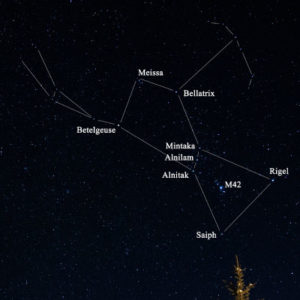THE USM SOUTHWORTH PLANETARIUM
207-780-4249 www.usm.maine.edu/planet
70 Falmouth Street Portland, Maine 04103
43.6667° N 70.2667° W
Altitude: 10 feet below sea level
Altitude: 10 feet below sea level
Founded January 1970
Julian date: 2458624.5
THE DAILY ASTRONOMER
Tuesday, May 21, 2019
Betelgeuse Bows Out
Tuesday, May 21, 2019
Betelgeuse Bows Out
for now, at least. For those of us who tick off the days with the stars, May 21st is a particularly important -and somber- date. Today marks the heliacal setting of Betelgeuse, the prominent red supergiant star in Orion the Hunter.

The stars of Orion. Even though the hunter is not currently
visible due to its close apparent proximity to the Sun, Betelgeuse
will be visible very briefly in this evening's western sky.
After tonight, Betelgeuse will be lost to our sight until late July.
Note: the other stars labeled in the above image are already too close
to the Sun to be seen.
This means that if one wants to see Betelgeuse, one should venture outside at dusk and look low along the western evening sky. Provided the sky is clear and your eyesight keen, you'll catch a fleeting glimpse of this star before it sets. If you miss it tonight, Betelgeuse won't be visible for about two months as it will appear too close to the Sun to be seen. Betelgeuse's heliacal rising occurs on July 21st: the first date when it will appear briefly in the eastern pre-dawn sky.*
Many might describe Betelgeuse's helical rising as the ultimate in non-events: something to be missed as it is so easily "miss-able." To us, its absorption into the dusk embers reminds us of time's inexorable passage: the joy at another winter's conclusion alloyed by the dread of the next's winter inevitable beginning. We also derive deep comfort from Betelgeuse's setting because we know the cosmic cycles churn without interruption despite life's triumphs and tribulations. Finally, we feel that disquieting sense of mortality that astronomy so effortlessly engenders in us: that Betelgeuse will be bowing out in May for a few more centuries, as it has done for centuries in the past. Recognizing this fact and its implications instills a febrile desire for life in us all too transitory humans.
*By this time, most of Orion's other stars will become visible, as well. However, if you truly wish to see Orion, it is best to wait until the first week of August.